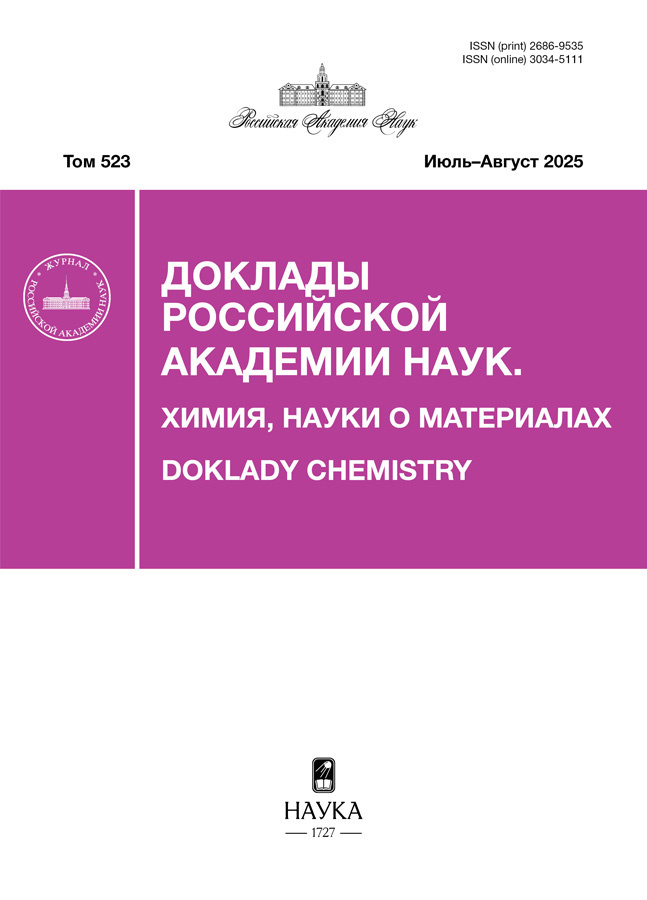Vol 523, No 1 (2025)
CHEMISTRY
Electron beam polymerization of phosphorus: MALDI-TOF analysis of product structure
Abstract
The article discusses the results of a study of the effect of the reaction medium composition (distilled water or aqueous solutions of acetonitrile and sodium hypophosphite) on the process of elemental phosphorus polymerization under the influence of accelerated electrons. Carrying out polymerization in an aqueous medium eliminates direct contact with air, which makes the process safer, and adding various chemicals to the solution allows to control the process parameters. It is shown that in an aqueous solution of acetonitrile and sodium hypophosphite, the conversion of phosphorus increases by 7%, and an increase in the polymerization rate is observed compared to using water as a reaction medium at the initial stage. The composition and structure of phosphorus-containing polymers obtained during electron beam polymerization were characterized by matrix-assisted laser desorption/ionization time-of-flight mass spectrometry (MALDI-TOF).
Doklady Rossijskoj akademii nauk. Himiâ, nauki o materialah.. 2025;523(1):3-10
 3-10
3-10


Synthesis of symmetrical 1,3-bis(polyfluorophenyl)ureas based on polyfluorobenzoic acid chlorides with potential antimicrobial action
Abstract
A one-pot method for the synthesis of symmetrical 1,3-bis(polyfluorophenyl)ureas based on an interaction of polyfluorobenzoic acid chlorides with sodium azide and subsequent Curtius rearrangement has been developed. It was found that 1,3-bis(3,4,5-trifluoro-2-methoxyphenyl)urea has a fungistatic effect on pathogenic dermatophyte strains and high antigonorrheal activity.
Doklady Rossijskoj akademii nauk. Himiâ, nauki o materialah.. 2025;523(1):11-17
 11-17
11-17


CRYSTALLIZATION OF THE SILICOALUMOPHOSPHATE MOLECULAR SIEVE SAPO-5 FROM REACTION GELS WITH DIFFERENT SiO2/Al2O3 RATIOS AND ITS APPLICATION IN HYDROISOMERIZATION OF n-HEXADECANE
Abstract
Microporous silicoaluminophosphate molecular sieves SAPO-5 are considered promising acidic catalysts for hydrocarbon conversion processes. However, their catalytic performance is hindered by diffusion limitations, which can be mitigated by reducing crystal size and fine-tuning the acidic properties. The effect of the initial SiO2/Al2O3 ratio in the synthesis gel on the structural and acidic features of SAPO-5 was investigated using XPS, XRD, SEM, N2 adsorption–desorption, NH3-TPD, and IR spectroscopy. An increase in silicon content was found to decrease crystal size and enhance the external surface area. The concentration of Brønsted acid sites reaches a maximum, suggesting limited Si incorporation into the framework. In the hydroisomerization of n-hexadecane, the highest catalytic activity and selectivity towards isoparaffins were observed for the SAPO-5 sample with the smallest crystals and the highest acidity. These findings demonstrate that the structural and acidic properties of SAPO-5 can be effectively controlled through adjustment of the synthesis gel composition.
Doklady Rossijskoj akademii nauk. Himiâ, nauki o materialah.. 2025;523(1):18-28
 18-28
18-28


PHYSICAL CHEMISTRY
Trends in the development of scientific research and the market in the field of liquid crystalline (lc) polymers and lc composites. Review article
Abstract
This article is a mini-review dedicated to liquid crystal polymers including our new experimental data on cholesteric liquid crystal composites. Liquid crystal polymers with mesogenic groups in the main chains (main-chain polymers) based on aromatic polyesters are used as super-strong heat-resistant structural materials in the automotive, aviation, and space industries. Liquid crystal polymers with mesogenic groups in the side chains (side-chain or comb-shaped polymers) are used as functional materials in optics and microelectronics for information recording and developing selective and reflective optical filters. The review presents new data from the last few years on cholesteric liquid crystal composites containing dispersions of cholesteric droplets in polyvinyl alcohol and polyurethane polymer matrices. The possibility of controlling optical properties and color of the studied liquid crystal composite films under the action of ultraviolet irradiation and mechanical deformation is demonstrated. Model diagrams are presented demonstrating changes in the spectral range of color images, as well as the possibility of recording hidden (latent) information with its subsequent visualization (verification) by mechanical deformation of liquid crystal composite films. These films can be used to protect packaging of pharmaceutical and alcoholic products from counterfeiting and falsification, as well as to protect securities and documents.
Doklady Rossijskoj akademii nauk. Himiâ, nauki o materialah.. 2025;523(1):29-41
 29-41
29-41


Singlet-triplet excitation of room-temperature phosphorescence of 1-bromonaphthalene–β-cyclodextrin–cyclohexane ternary complexes
Abstract
The spectra and kinetics of room-temperature phosphorescence of ternary complexes of 1-chloronaphthalene and 1-bromonaphthalene with β-cyclodextrin and cyclohexane were studied. The lifetimes of phosphorescence of ternary complexes measured at room temperature in the absence of oxygen were 214 and 10 ms for 1-chloronaphthalene and 1-bromonaphthalene, respectively. Triplet-triplet annihilation was detected for 1-bromonaphthalene complexes and the possibility of direct excitation of triplet states as a result of singlet-triplet absorption was shown.
Doklady Rossijskoj akademii nauk. Himiâ, nauki o materialah.. 2025;523(1):42-49
 42-49
42-49


The Effect of Cryochemical Synthesis Parameters of Iron Oxide Nanoparticles on Their Size, Structure and Magnetic Properties
Abstract
In this work, cryochemical approaches are used to obtain nanoparticles of magnetic iron oxides of various compositions and morphologies. Cryochemical coprecipitation of iron(II) and (III) salts with an ammonia solution in the temperature range from –30 to –50°C leads to the formation of single-domain superparamagnetic maghemite nanoparticles with an average size of 6 ± 2 nm, which is smaller than the average particle size (20 ± 2 nm) obtained by the classical coprecipitation method. However, cryochemical coprecipitation leads to the formation of goethite impurity. Single-domain superparamagnetic magnetite nanoparticles with an average diameter of 10 ± 2 nm without goethite impurity can be obtained by cryochemical precipitation of iron(II) sulfate with ammonia in air. Thermal decomposition of cryomodified iron salts allows obtaining maghemite nanoparticles of 40–300 nm in size in the case of iron(III) acetylacetonate and iron(III) formate, as well as micron-sized maghemite and goethite particles of complex shape in the case of iron(III) ammonium citrate and iron(II) gluconate.
Doklady Rossijskoj akademii nauk. Himiâ, nauki o materialah.. 2025;523(1):50-60
 50-60
50-60










